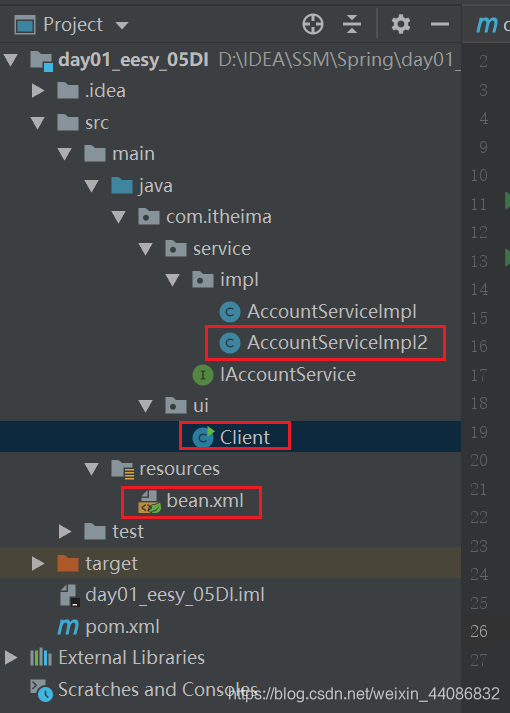4. 依赖注入
文章目录
Spring中的依赖注入:
- 依赖注入:
Dependency Injection - IOC的作用:
降低程序间的依赖耦合(依赖关系) - 依赖关系的管理:
以后都交给Spring来维护 - 在当前类需要用到其它类的对象的时候, 由Spring为我们提供, 我们只需要在配置文件中说明
- 依赖关系的维护, 就称之为依赖注入
- 依赖注入:
能注入的数据 有三类:
基本类型和String
其他bean类型(在配置文件中或者注解配置过的bean)
复杂类型/集合类型
注入的方式 有三种:
第一种: 使用构造函数提供
第二种: 使用set方法提供
第三种: 使用注解提供(明天的内容)
- 依赖注入:
准备工作:
1. 创建项目 day01_eesy_05DI
-
进行 pom.xml的相关配置, 导入Spring框架所需要的jar包
-
将项目 day01_eesy_04bean 中 src/main 目录下的文件复制到 day01_eesy_05DI 的 src/main目录下
-
将 factory相关文件及 AccountServiceImpl.java 的 init 和 destroy 方法删除
-
目录结构

4.1 构造函数注入
4.1.1 构造函数注入介绍
构造函数注入
使用的标签: constructor-arg
标签出现的位置: bean标签的内部
标签的属性:
type: 用于指定要注入的数据的数据类型, 该数据类型也是构造函数中某个或某些参数的类型
index: 用于指定要注入的数据 给构造函数中指定索引位置的参数赋值,索引的位置是从0开始
name: 用于指定给构造函数中指定名称的参数赋值 常用
==以上三个用于指定给构造函数中哪个参数赋值=
value: 用于提供基本类型和String类型的数据
ref: 用于指定其他的bean类型数据; 他只得就是在Spring的IOC核心容器中出现过的bean对象
优势:
在获取bean对象是,注入数据是必须的操作,否则对象无法创建成功
弊端:
改变了bean对象的实例化方式,使我们在创建对象时,如果用不到这些数据,也必须提供
4.1.2 案例
-
修改业务层 AccountServiceImpl.java 的构造函数, 以及saveAccount 方法,添加成员变量
//账户的业务层实现类 public class AccountServiceImpl implements IAccountService { //说明: 如果是经常变化的数据, 并不适用于注入的方式 private String name; private Integer age; private Date birthday; public AccountServiceImpl(String name, Integer age, Date birthday){ this.name = name; this.age = age; this.birthday = birthday; } public void saveAccount() { System.out.println("saveAccount方法执行了"+ name +age +birthday); } } -
在bean.xml中完成相关配置,进行构造函数注入
<?xml version="1.0" encoding="UTF-8"?> <beans xmlns="http://www.springframework.org/schema/beans" xmlns:xsi="http://www.w3.org/2001/XMLSchema-instance" xsi:schemaLocation="http://www.springframework.org/schema/beans http://www.springframework.org/schema/beans/spring-beans.xsd"> <!-- Spring中的依赖注入: 依赖注入: Dependency Injection IOC的作用: 降低程序间的依赖耦合(依赖关系) 依赖关系的管理: 以后都交给Spring来维护 在当前类需要用到其它类的对象的时候, 由Spring为我们提供, 我们只需要在配置文件中说明 依赖关系的维护, 就称之为依赖注入 依赖注入: 能注入的数据 有三类: 基本类型和String 其他bean类型(在配置文件中或者注解配置过的bean) 复杂类型/集合类型 注入的方式 有三种: 第一种: 使用构造函数提供 第二种: 使用set方法提供 第三种: 使用注解提供(明天的内容) --> <!-- 构造函数注入 使用的标签: constructor-arg 标签出现的位置: bean标签的内部 标签的属性: type: 用于指定要注入的数据的数据类型, 该数据类型也是构造函数中某个或某些参数的类型 index: 用于指定要注入的数据 给构造函数中指定索引位置的参数赋值,索引的位置是从0开始 name: 用于指定给构造函数中指定名称的参数赋值 常用 ================以上三个用于指定给构造函数中哪个参数赋值=========================== value: 用于提供基本类型和String类型的数据 ref: 用于指定其他的bean类型数据; 他只得就是在Spring的IOC核心容器中出现过的bean对象 优势: 在获取bean对象是,注入数据是必须的操作,否则对象无法创建成功 弊端: 改变了bean对象的实例化方式,使我们在创建对象时,如果用不到这些数据,也必须提供 --> <bean id="accountService" class="com.itheima.service.impl.AccountServiceImpl"> <constructor-arg name="name" value="text"></constructor-arg> <constructor-arg name="age" value="18"></constructor-arg> <constructor-arg name="birthday" ref="now"></constructor-arg> </bean> <bean id="now" class="java.util.Date"></bean> </beans> -
在模拟表现层中进行运行
//模拟一个表现层,用于调用业务层 public class Client { public static void main(String[] args) { //1.获取核心容器对象 ApplicationContext applicationContext = new ClassPathXmlApplicationContext("bean.xml"); //2.根据id获取bean对象 IAccountService accountService = (IAccountService) applicationContext.getBean("accountService"); accountService.saveAccount(); } } -
运行结果

4.2 set方法注入
4.2.1 set方法注入介绍
set方法注入:
涉及的标签: property
出现的位置: bean标签的内部
标签的属性:
name: 用于指定注入时所调用的set方法名称
value: 用于提供基本类型和String类型的数据
ref: 用于指定其他的bean类型数据; 他指的就是在Spring的IOC核心容器中出现过的bean对象
4.2.2 案例
-
创建业务层 AccountServiceImpl2.java
//账户的业务层实现类 public class AccountServiceImpl2 implements IAccountService { //说明: 如果是经常变化的数据, 并不适用于注入的方式 private String name; private Integer age; private Date birthday; public void setName(String name) { this.name = name; } public void setAge(Integer age) { this.age = age; } public void setBirthday(Date birthday) { this.birthday = birthday; } public void saveAccount() { System.out.println("saveAccount方法执行了 "+ name+" " +age+" " +birthday); } } -
在配置文件 bean.xml中完成配置
<?xml version="1.0" encoding="UTF-8"?> <beans xmlns="http://www.springframework.org/schema/beans" xmlns:xsi="http://www.w3.org/2001/XMLSchema-instance" xsi:schemaLocation="http://www.springframework.org/schema/beans http://www.springframework.org/schema/beans/spring-beans.xsd"> <!-- Spring中的依赖注入: 依赖注入: Dependency Injection IOC的作用: 降低程序间的依赖耦合(依赖关系) 依赖关系的管理: 以后都交给Spring来维护 在当前类需要用到其它类的对象的时候, 由Spring为我们提供, 我们只需要在配置文件中说明 依赖关系的维护, 就称之为依赖注入 依赖注入: 能注入的数据 有三类: 基本类型和String 其他bean类型(在配置文件中或者注解配置过的bean) 复杂类型/集合类型 注入的方式 有三种: 第一种: 使用构造函数提供 第二种: 使用set方法提供 第三种: 使用注解提供(明天的内容) --> <!-- 构造函数注入 使用的标签: constructor-arg 标签出现的位置: bean标签的内部 标签的属性: type: 用于指定要注入的数据的数据类型, 该数据类型也是构造函数中某个或某些参数的类型 index: 用于指定要注入的数据 给构造函数中指定索引位置的参数赋值,索引的位置是从0开始 name: 用于指定给构造函数中指定名称的参数赋值 常用 ================以上三个用于指定给构造函数中哪个参数赋值=========================== value: 用于提供基本类型和String类型的数据 ref: 用于指定其他的bean类型数据; 他只得就是在Spring的IOC核心容器中出现过的bean对象 优势: 在获取bean对象是,注入数据是必须的操作,否则对象无法创建成功 弊端: 改变了bean对象的实例化方式,使我们在创建对象时,如果用不到这些数据,也必须提供 --> <bean id="accountService" class="com.itheima.service.impl.AccountServiceImpl"> <constructor-arg name="name" value="text"></constructor-arg> <constructor-arg name="age" value="18"></constructor-arg> <constructor-arg name="birthday" ref="now"></constructor-arg> </bean> <!--配置一个日期对象--> <bean id="now" class="java.util.Date"></bean> <!-- set方法注入: 涉及的标签: property 出现的位置: bean标签的内部 标签的属性: name: 用于指定注入时所调用的set方法名称 value: 用于提供基本类型和String类型的数据 ref: 用于指定其他的bean类型数据; 他指的就是在Spring的IOC核心容器中出现过的bean对象 --> <bean id="accountService2" class="com.itheima.service.impl.AccountServiceImpl2"> <property name="name" value="Test"></property> <property name="age" value="18"></property> <property name="birthday" ref="now"></property> </bean> -
在模拟表现Client.java中运行
//模拟一个表现层,用于调用业务层 public class Client { public static void main(String[] args) { //1.获取核心容器对象 ApplicationContext applicationContext = new ClassPathXmlApplicationContext("bean.xml"); //2.根据id获取bean对象 // IAccountService accountService = (IAccountService) applicationContext.getBean("accountService"); // accountService.saveAccount(); IAccountService accountService = (IAccountService) applicationContext.getBean("accountService2"); accountService.saveAccount(); } } -
运行结果

5. 目录结构

4.3 注入集合数据
4.3.1 集合数据注入介绍
复杂类型的注入/集合类型的注入
- 用于给List结构集合注入的标签有:
list array set - 用于给Map结构集合注入的标签有:
map props
结构相同, 标签可以互换
4.3.2 案例
-
创建业务实现类AccountServiceImpl3.java
//账户的业务层实现类 public class AccountServiceImpl3 implements IAccountService { private String[] myStrs; private List<String> myList; private Set<String> mySet; private Map<String,String> myMap; private Properties myProps; public void setMyStrs(String[] myStrs) { this.myStrs = myStrs; } public void setMyList(List<String> myList) { this.myList = myList; } public void setMySet(Set<String> mySet) { this.mySet = mySet; } public void setMyMap(Map<String, String> myMap) { this.myMap = myMap; } public void setMyProps(Properties myProps) { this.myProps = myProps; } public void saveAccount() { System.out.println(Arrays.toString(myStrs)); System.out.println(myList); System.out.println(mySet); System.out.println(myMap); System.out.println(myProps); } }-
在配置文件bean.xml中完成配置
<?xml version="1.0" encoding="UTF-8"?> <beans xmlns="http://www.springframework.org/schema/beans" xmlns:xsi="http://www.w3.org/2001/XMLSchema-instance" xsi:schemaLocation="http://www.springframework.org/schema/beans http://www.springframework.org/schema/beans/spring-beans.xsd"> <!-- Spring中的依赖注入: 依赖注入: Dependency Injection IOC的作用: 降低程序间的依赖耦合(依赖关系) 依赖关系的管理: 以后都交给Spring来维护 在当前类需要用到其它类的对象的时候, 由Spring为我们提供, 我们只需要在配置文件中说明 依赖关系的维护, 就称之为依赖注入 依赖注入: 能注入的数据 有三类: 基本类型和String 其他bean类型(在配置文件中或者注解配置过的bean) 复杂类型/集合类型 注入的方式 有三种: 第一种: 使用构造函数提供 第二种: 使用set方法提供 第三种: 使用注解提供(明天的内容) --> <!-- 构造函数注入 使用的标签: constructor-arg 标签出现的位置: bean标签的内部 标签的属性: type: 用于指定要注入的数据的数据类型, 该数据类型也是构造函数中某个或某些参数的类型 index: 用于指定要注入的数据 给构造函数中指定索引位置的参数赋值,索引的位置是从0开始 name: 用于指定给构造函数中指定名称的参数赋值 常用 ================以上三个用于指定给构造函数中哪个参数赋值=========================== value: 用于提供基本类型和String类型的数据 ref: 用于指定其他的bean类型数据; 他只得就是在Spring的IOC核心容器中出现过的bean对象 优势: 在获取bean对象是,注入数据是必须的操作,否则对象无法创建成功 弊端: 改变了bean对象的实例化方式,使我们在创建对象时,如果用不到这些数据,也必须提供 --> <bean id="accountService" class="com.itheima.service.impl.AccountServiceImpl"> <constructor-arg name="name" value="text"></constructor-arg> <constructor-arg name="age" value="18"></constructor-arg> <constructor-arg name="birthday" ref="now"></constructor-arg> </bean> <!--配置一个日期对象--> <bean id="now" class="java.util.Date"></bean> <!-- set方法注入: 更常用的方式 涉及的标签: property 出现的位置: bean标签的内部 标签的属性: name: 用于指定注入时所调用的set方法名称 value: 用于提供基本类型和String类型的数据 ref: 用于指定其他的bean类型数据; 他指的就是在Spring的IOC核心容器中出现过的bean对象 优势: 创建对象时没有明确的限制,可以直接使用默认构造函数 弊端: 如果有某个成员必须有值, 则获取对象时有可能set方法没有执行 --> <bean id="accountService2" class="com.itheima.service.impl.AccountServiceImpl2"> <property name="name" value="Test"></property> <property name="age" value="18"></property> <property name="birthday" ref="now"></property> </bean> <!-- 复杂类型的注入/集合类型的注入 用于给List结构集合注入的标签有: list array set 用于给Map结构集合注入的标签有: map props 结构相同, 标签可以互换 --> <bean id="accountService3" class="com.itheima.service.impl.AccountServiceImpl3"> <property name="myStrs"> <array> <value>aaa</value> <value>bbb</value> <value>ccc</value> </array> </property> <property name="myList"> <list> <value>aaa</value> <value>bbb</value> <value>ccc</value> </list> </property> <property name="mySet"> <set> <value>aaa</value> <value>bbb</value> <value>ccc</value> </set> </property> <property name="myMap"> <map> <entry key="testA" value="aaa"></entry> <entry key="testB"> <value>bbb</value> </entry> </map> </property> <property name="myProps"> <props> <prop key="teatA">aaa</prop> <prop key="testB">bbb</prop> </props> </property> </bean> </beans> -
在模拟表现层Client.java中运行
//模拟一个表现层,用于调用业务层 public class Client { public static void main(String[] args) { //1.获取核心容器对象 ApplicationContext applicationContext = new ClassPathXmlApplicationContext("bean.xml"); //2.根据id获取bean对象 // IAccountService accountService = (IAccountService) applicationContext.getBean("accountService"); // accountService.saveAccount(); // IAccountService accountService = (IAccountService) applicationContext.getBean("accountService2"); // accountService.saveAccount(); IAccountService accountService = (IAccountService) applicationContext.getBean("accountService3"); accountService.saveAccount(); } } -
运行结果
-

5. 目录结构
























 496
496











 被折叠的 条评论
为什么被折叠?
被折叠的 条评论
为什么被折叠?








